From Holy Grail to dodo: how the legendary SynthAxe went from being "the future of the electric guitar" to "way beyond what most guitarists could comprehend"
But if you own this rare and mythical musical instrument beast, then the drinks are on you…
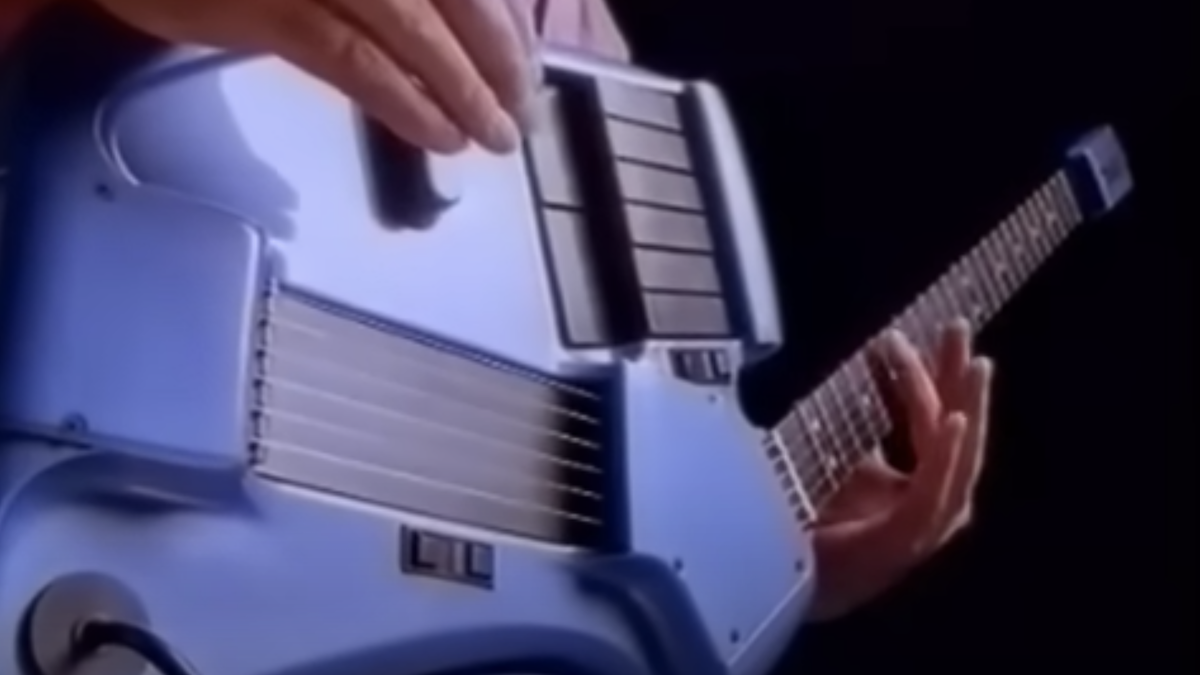
The story of the SynthAxe is an almost mythical tale of entrepreneurship, courage, design brilliance and dogged determination. Unfortunately it's also one of overconfidence, expensive ambition and (maybe) a lack of realisation of what musicians require and (definitely) how much effort they are prepared to make to embrace something new. But the fact that anyone got this futuristic musical instrument to market is a miracle, and the story behind it is quite incredible.
So what exactly was SynthAxe? A guitar? A synth? A controller? Performance instrument? A completely new way of making and playing sound? In truth it was (a bit of) all of these. And if you own one of the 100 or so units made, you not only own a piece of music history, but one of the most ambitious instruments ever created (not to mention a sizeable investment).
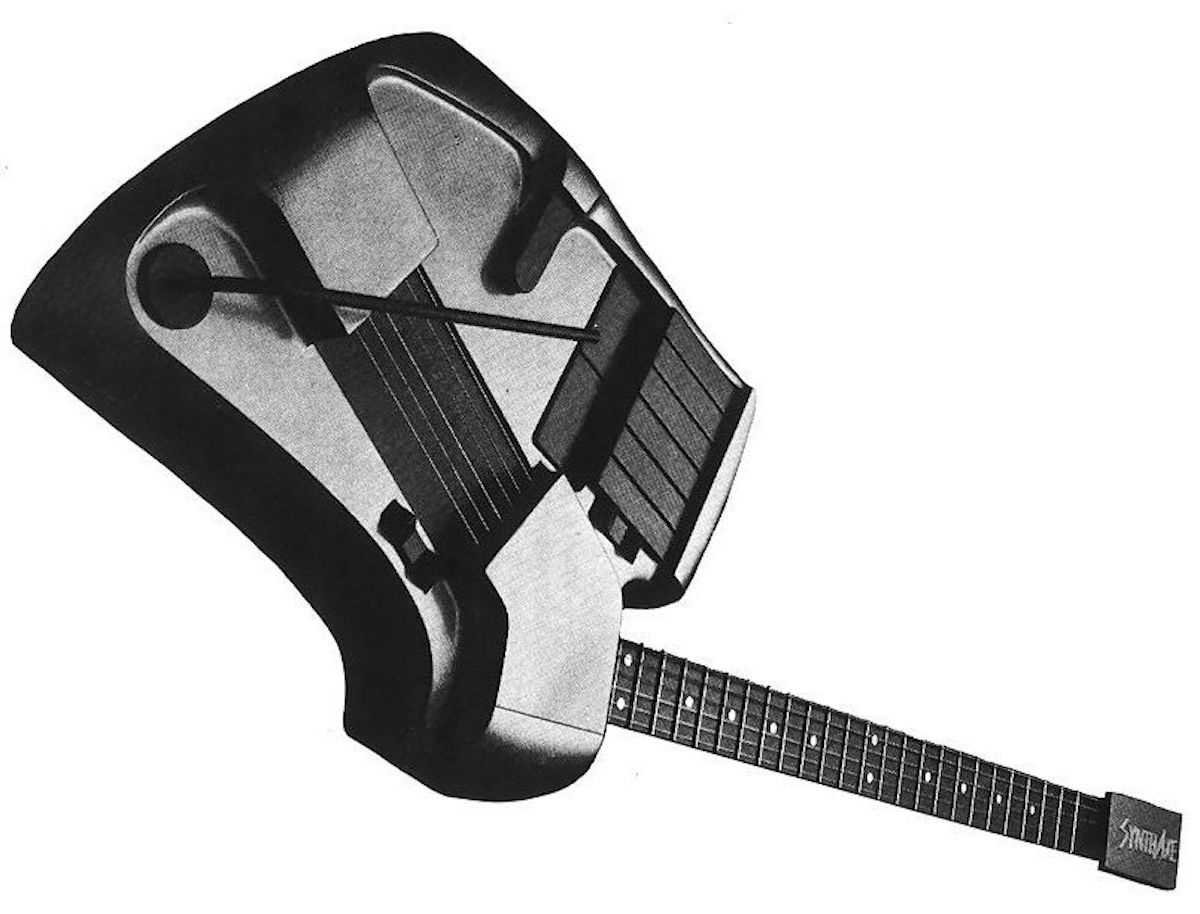
When it was announced in the early 1980s, the SynthAxe was one of the most eagerly anticipated musical instruments of the time, a guitar-like MIDI controller that could feed pitch, volume and other information to external MIDI synths and samplers to trigger them.
Unlike guitar synths, which tended to be more about playing a guitar as normal and triggering notes, SynthAxe required new ways of playing, but this could mean it was a more expressive option.
SynthAxe required new ways of playing, but this could mean it was a more expressive instrument.
The story behind SynthAxe is as crazy as the concept, with Virgin Records involved, as were the makers of the Fairlight sampler, with many more design twists and turns along the way. And we’re not sure that any such instrument could be developed even today, especially by a small company with little background in business and instrument design.
The people behind SynthAxe were Bill Aitken, Mike Dixon and Tony Sedivy, who started contemplating the instrument in the '70s when the first guitar synths were introduced. Early pre-MIDI guitar synths would use a CV/gate system to translate guitar note frequencies to voltage, and Aitken and Dixon weren’t happy with the results, deciding that they could do better.
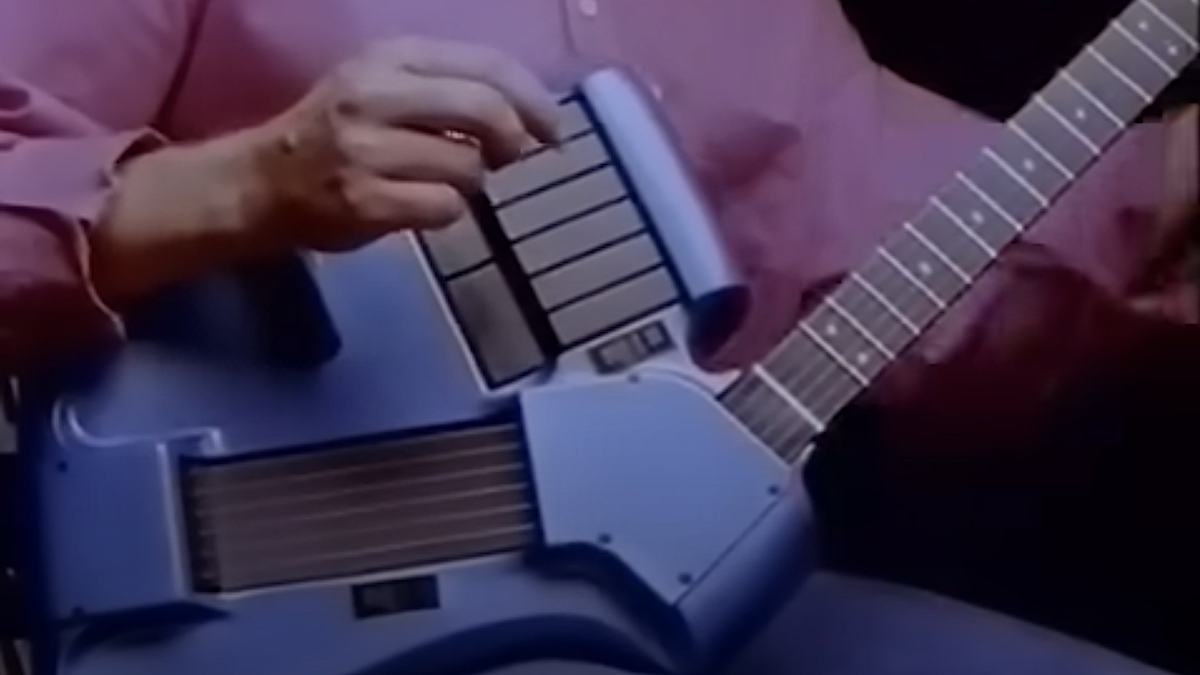
What eventually became SynthAxe didn’t rely on the frequencies of the vibrating strings, but sensors detecting how hard a string was struck. The string’s tuning was unimportant; it was where it touched the fret that was.
Get the MusicRadar Newsletter
Want all the hottest music and gear news, reviews, deals, features and more, direct to your inbox? Sign up here.
This was dealt with by a set of strings on the left of SynthAxe, resembling the neck of a standard guitar. An unconnected set of strings on the right dealt with velocity, bend and other performance settings.
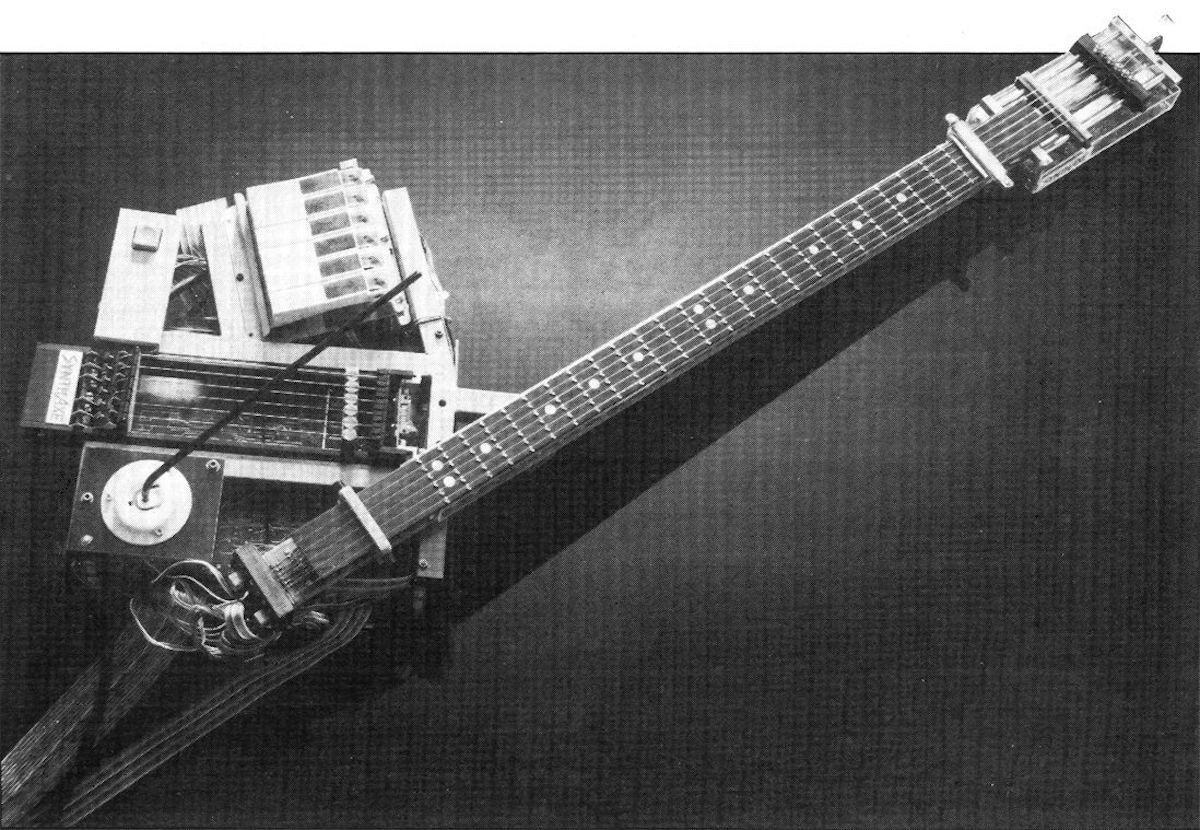
After a long design period, SynthAxe started to slowly take shape, its early incarnation being called 'Frankenstein'; thanks to its rather 'bits and pieces' initial design.
Our very own Neville Marten, former editor of Guitarist and long-time MusicRadar contributor, was introduced to SynthAxe early in its development and details his first meeting with the guitar and synth monster.
I instantly got it, as I reckon about 20 percent of guitarists did. Bill Aitken was the inventor and was brilliant, eloquent and evangelistic.
Neville Marten
“I was working for Fender as a guitar repairer and the Fender artist relations manager took me to the HQ to see, try and asses it," he explains. "The Frankenstein version was just the primitive electronics in a chassis – like a car with no body. I instantly got it, as I reckon about 20 percent of guitarists did. Bill Aitken was the inventor and was brilliant, eloquent and evangelistic."
Neville got on so well with SynthAxe that he ended up working for the company and demoing the unit, as this video from the time reveals.
The SynthAxe design team wanted to send out all of the note and performance information via MIDI, but the problem was that MIDI hadn't been invented during the instrument's conception, so, remarkably, they came up with a similar standard themselves.
“Yes it was so revolutionary," Nev confirms, "that the engineers, Tony Sedivy and Mike Dixon (and perhaps others) even designed a pre-MIDI MIDI. Obviously they soon had to conform to its universality eventually. But Bill’s concept was so advanced: that a guitarist could play state-of-the-art synthesizers using their own technique was unbelievable.”
It was so revolutionary that engineers Tony Sedivy and Mike Dixon even designed a pre-MIDI MIDI.
The designers of SynthAxe had to wait until the MIDI standard came along to fully realise their ambitions. But eventually the unit would be able to send out information conforming to the full standard, so you could, for example, send damping data or affect a synth filter all using the onboard controllers.
It didn’t end there either. Later designs featured a number of other buttons and controls on SynthAxe to affect how notes were played as you could assign different MIDI controllers to each. There was an additional pedal system too. Yes, this really was no guitar synth, nor guitar, but a completely new instrument.

Even though it had a rumoured £12,000 price tag, the media of the time got super excited about SynthAxe when they first got hold of a prototype in 1984. In June of that year, One Two Testing magazine said that even though “the prototype is a bitch to play” it looked like SynthAxe had “re-routed the future of the electric guitar” and that “you and I may never be able to afford one, but we'll be hearing them”.
The prototype is a bitch to play, but it looks to have re-routed the future of the electric guitar
One Two Testing magazine, 1984
Meanwhile Paul White in Electronics and Music Maker’s June edition detailed more about SynthAxe’s prolonged development, revealing a Yamaha CS80 that had fallen down a lift shaft was the first synth controlled by a SynthAxe.
“Unfortunately, the ground broke more than just its fall and Mike and Tony had the rather thankless task of rebuilding it,” he wryly noted.
Not only that but he detaIled how Virgin Records had to step in and finance the project after synthAxe had spent years developing it, and how the designers behind the original Fairlight CMI sampler came on board to help out.
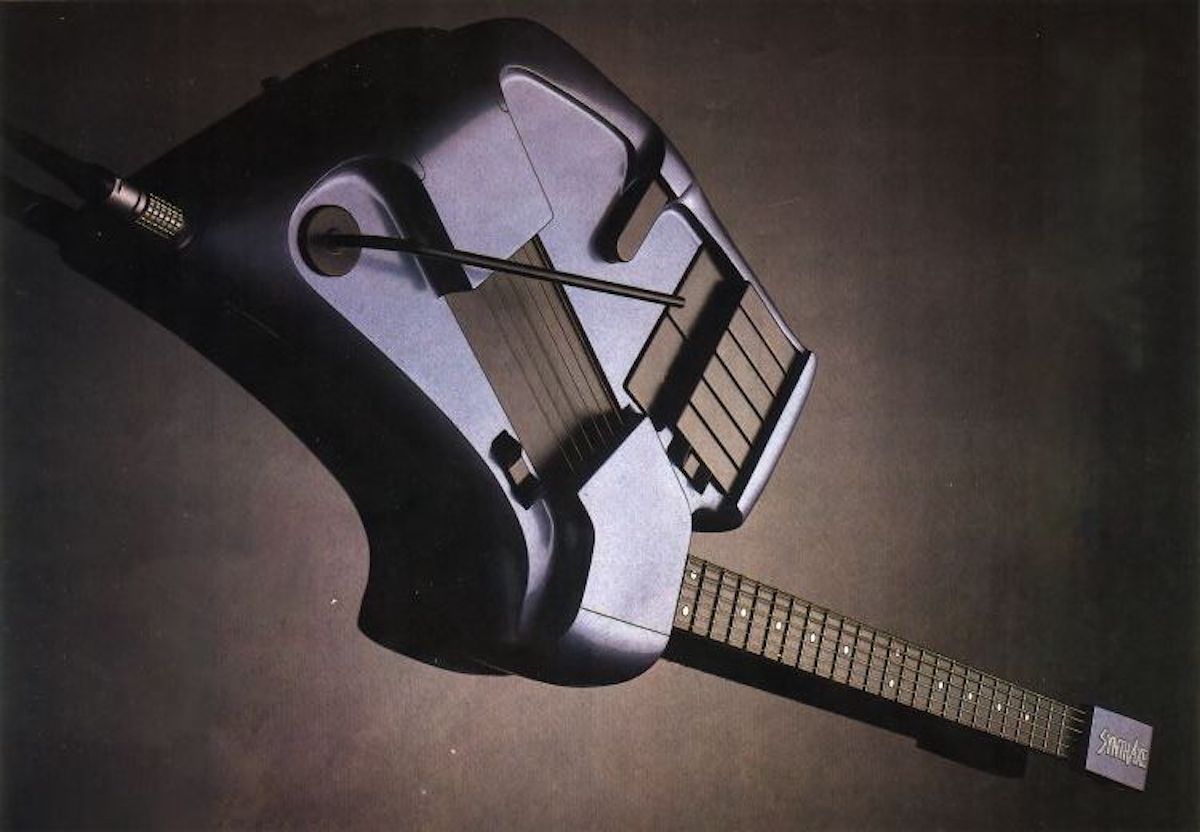
Paul concluded: “what we saw was enough to convince us of the enormous potential of this remarkable instrument. To be able to fingerpick a grand piano or apply a bit of vibrato arm to a string quartet is certainly a novel experience. SynthAxe is capable of producing music that would be impossible on either a guitar or a keyboard.”
However, it would be a full year before anyone got their hands on a finished unit and by this time the likes of Gary Moore and Phil Manzanera had become early endorsees of the SynthAxe.
SynthAxe is capable of producing music that would be impossible on either a guitar or a keyboard
Paul White
On seeing the former wield SynthAxe for the first time, Electronic Sound Maker and Computer Music magazine was in awe: "In such an expert's hands I can assure you the SynthAxe is an instrument to be reckoned with – quite feasibly able to out-manoeuvre conventional synthesists with a flick-of the wrist.”
One Two Testing paid a second visit to the SynthAxe saying, “Bill Aitken assured me that no more than a dozen people in the world had played this sample. They'd all made it sound completely different, and most had come up with fresh methods of playing it even the inventors hadn't envisaged. What is vital about this device is its vast potential for new techniques and forms of expression."
Paul White had also come to similar conclusions stating, “the unique facilities offered by this system could well foster a variety of new and exciting playing styles”.
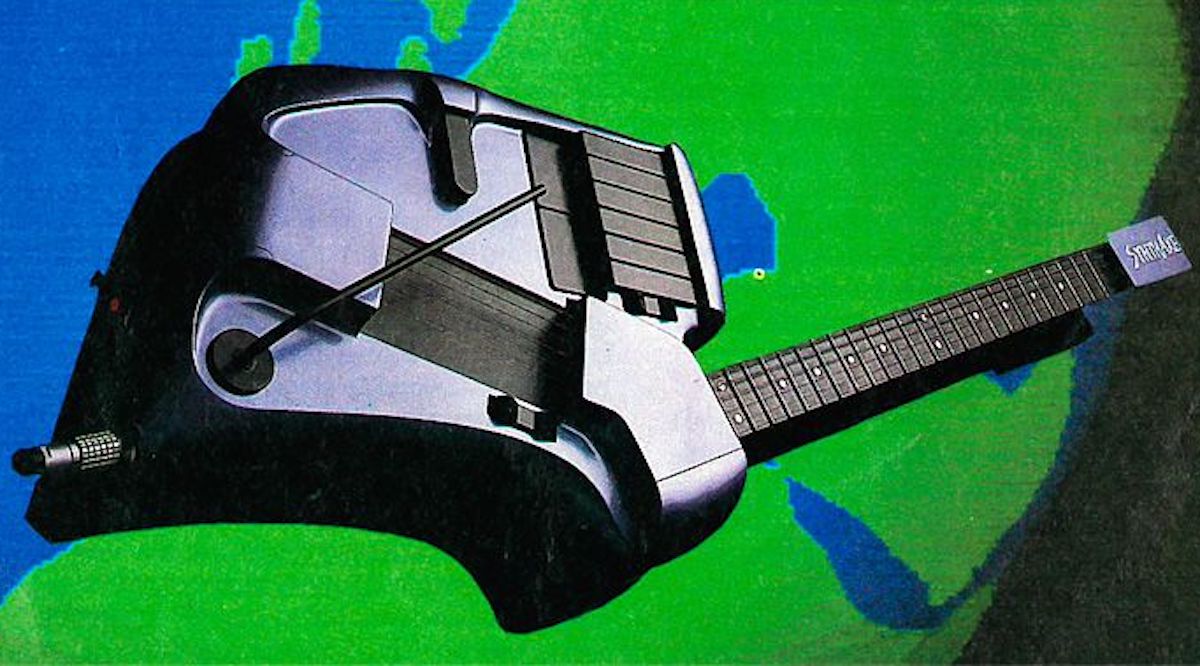
As enthusiastic as these early reviews were, it might well have been the learning curve of these extra playing styles that would become the main stumbling block to more people actually buying the instrument. Well, that and the price.
SynthAxe eventually came out in 1985, initially priced at well over £10,000 – too much for most non-risk takers. Neville Marten agrees that the price and extra playing skills required would contribute to SynthAxe's downfall, but that other factors were also involved.
Much like a supercar or a Saturn rocket, it required a degree of aftercare! A Fender Strat doesn’t.
Neville Marten
"Although it wasn’t intrinsically unreliable," he says, "much like a supercar or a Saturn rocket, it required a degree of aftercare! A Fender Strat doesn’t. Towards the end they got Akai on board and came up with a cheaper version – the big one was £9,000 in 1985. But by then the writing was on the wall…"
However, the SynthAxe was adopted by some high-profile users. Gary Moore kept being an advocate and used the SynthAxe in this video for the track Out In The Fields with Phil Lynott (around 1:50 seconds in).
Allan Holdsworth became something of a SynthAxe champion, even becoming an on-stand demonstrator at a couple of NAMM shows. He used it across several excellent albums, and on several YouTube videos like this one…
And other famous users included Chris Currell, who used a SynthAxe to control a Synclavier on stage for Michael Jackson’s Bad tour, and jazz musician Lee Ritenour.
Sadly though, there was not so much adoption of the instrument beyond these and only 100 units were ever built which is a shame for an almost decade-long project.
"If it could have succeeded it would have," notes Neville Marten. "Really, that thing was amazing. We played an Oberheim Matrix 12 and Xpander with it. We even had a Yamaha TX816 (essentially a bank of DX7s) and we could assign a string to each of six modules!
Bill Aitken’s vision was way beyond what most guitarists could comprehend.
Neville Marten
"Bill Aitken’s vision was way beyond what most guitarists could comprehend," he concludes. "Once you understood what could be achieved with the various keys, hold features and ADRS variables it was unbelievably powerful. But most guitarists had no desire to go that deep."
As only 100 SynthAxe units were rumoured to have been made, you obviously don't see them go up for sale that much. We've seen an Allan Holdsworth-owned model sell for around £12,000 – ironically the original asking price – but some have been advertised (although not necessarily sold) for three times that.
Either way, if you own one, you're sitting on a decent investment and one of the most ambitious but perhaps flawed instruments ever to see the light of day.
- Read more: The History of the Guitar Synth.


Andy has been writing about music production and technology for 30 years having started out on Music Technology magazine back in 1992. He has edited the magazines Future Music, Keyboard Review, MusicTech and Computer Music, which he helped launch back in 1998. He owns way too many synthesizers.










